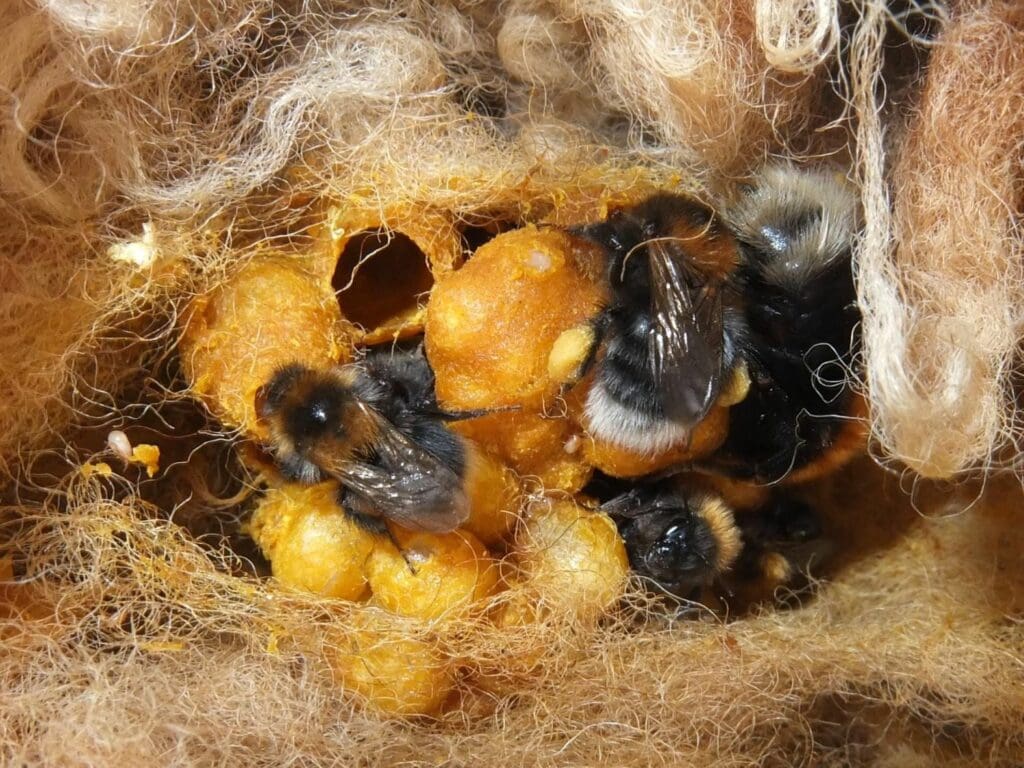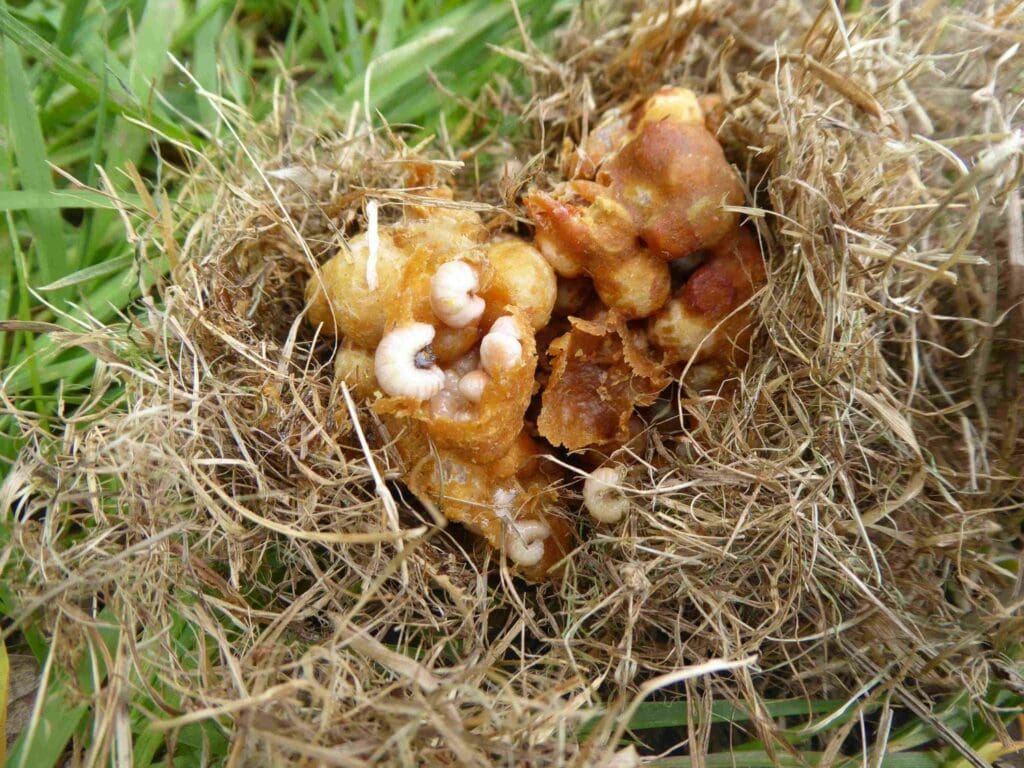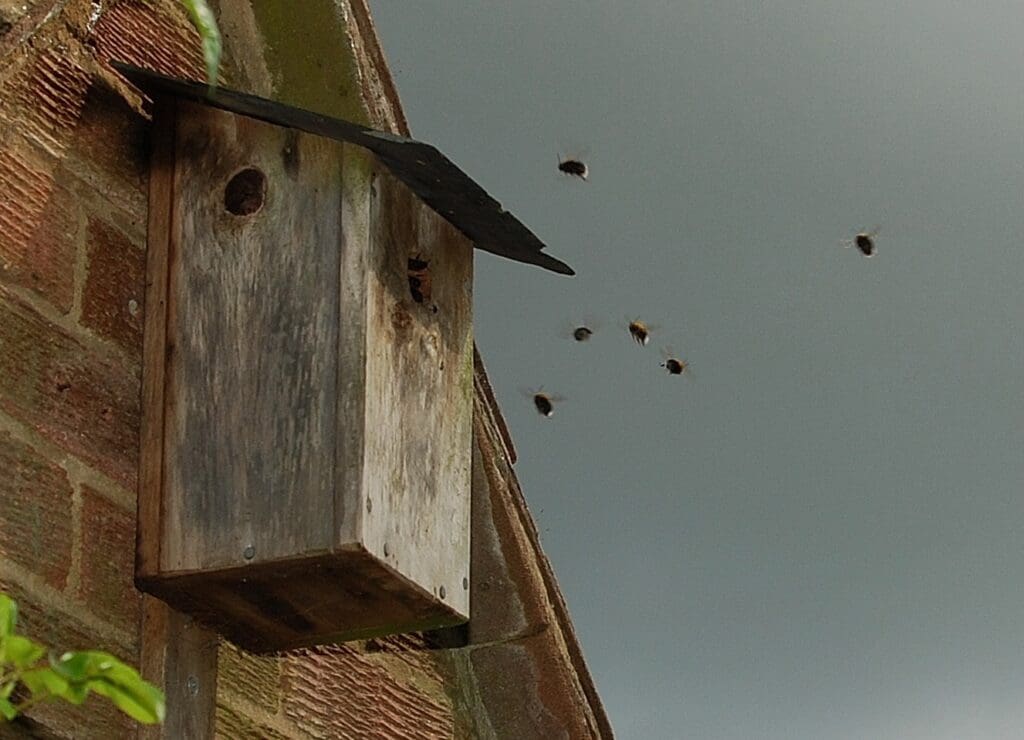Bumblebee nests
In spring bumblebee queens begin to emerge from hibernation. Once they have fully woken up and recovered from their long winter hibernation, they get busy looking for somewhere to set up their nest so can they raise the next generation of bumblebees.
Every year, we get lots of questions about bumblebee nests, so we have compiled the most common ones here for you.

What do bumblebees look for in a nest site?
Most bumblebee queens look for dry, enclosed spaces which have some sort of insulating material already inside. Nests can be found in all sorts of unexpected places but, in general, bumblebees avoid wet areas and locations that get lots of sun as this can heat the nest up too much.
Some species are commonly found nesting underground, in places such as abandoned rodent holes, under sheds and in compost heaps. Others prefer to be on the surface of the ground and make nests in thick grass or mossy vegetation. There are also some species which tend to be found nesting a little higher up in bird boxes, roof spaces, wall cavities and even in tree holes.
How does a queen bumblebee find a good nest spot?
When she is ready to start looking for a nest site the queen will fly in a slow and distinctive zig zag pattern, often low over the ground or around features that might be suitable. As she does this, she uses both her sight and smell to guide her. If she spots a potential site, she will land and crawl in to investigate further. She can disappear for a few minutes at a time but if it proves unsuitable, she will emerge and continue her search.
An exception to this behaviour is the six cuckoo bumblebee species. The female cuckoo bees emerge a few weeks after their preferred social bumblebee hosts and begin to search for established nests. When they find a nest, they will enter and fight with the queen. Cuckoos are a bit tougher than their hosts so they can overpower the queen and take over the nest. The worker bumblebees, who are the daughters of the original queen, will then look after the cuckoo eggs and larvae until they develop into new female and male cuckoo bumblebees.

Credit: Clare Flynn
What is the nest made of?
Unlike the distinctive honeybee nest, which has tightly packed hexagonal cells for raising offspring and storing honey, the inside of the bumblebee nest can appear quite messy and disorganised.
There are little wax pots (used to store nectar), wax brood cells, and a wax covering. The silk cocoons of the bees developing into adults can also be seen.
What size is a bumblebee nest?
Bumblebee nests vary in size depending on the species and time of year.
At the start of the nest the queen is alone. Over the coming weeks, as she raises batches of eggs which develop into worker bumblebees who help with the foraging and nest care duties, the nest grows. After a few months, a well-established nest can contain up to 400 bumblebees and could be around the size of a small football. However, some species have much smaller nests with only around 50 workers at their most active. A honeybee hive can contain 50,000 bees so bumblebee nests are very small in comparison.
How long does a bumblebee nest last?
Bumblebee nests usually last between 2 and 6 months. This depends on factors such as food availability, weather and which bumblebee species the nest belongs to.
Some species, such as the Tree bumblebee (Bombus hypnorum), tend to have predictable and quite short nesting periods whereas others, such as the Common carder bumblebee (Bombus pascuorum), can have longer nesting periods with less predictable start and finish points.
Bumblebee queens always start their own nest from scratch so once a nest is finished it won’t be used again. However, the same location, such as a nest box or roof space, might be used again by a different queen.
What to do if you find a bumblebee nest
If you find a bumblebee nest, consider yourself very lucky! They aren’t very common and can be difficult to find.
Although some people can be worried when they find a bumblebee nest, we generally recommend that nests are left alone and in place. They don’t last very long, just a few months, and don’t cause any structural damage. The presence of a nest is often only noticed when the nest is well established, and possibly even approaching its end, as there is more bee ‘traffic’ (bees coming and going) so it might be finished sooner than you think.
If left alone, bumblebees are generally calm creatures who quietly go about their business visiting flowers and usually avoid or don’t pay any attention to people. Female bumblebees (queens, workers and cuckoo females) will usually only sting defensively if they feel threatened by someone or something, for example vibration from a lawnmower, getting too close to the nest. Male bumblebees don’t have a sting and so, even if they wanted to, they can’t harm people.
We understand that it might be inconvenient to have a bumblebee nest entrance outside a bedroom window or in the garden, however some temporary adjustments can help you live with your short-term bumblebee neighbours.
- Use fine netting to cover window openings. Bumblebees don’t mean to come indoors but sometimes take the wrong entrance.
- Use temporary fencing or barriers to keep pets and small children away from nest entrances. Something like an upturned wire hanging basket might give the bumblebees the space they need to safely enter and exit their nest.
- Move play equipment or garden seating to another area of the garden. Avoid making too much noise or vibration right next to the nest.

Credit: Jamie Buxton-Gould
What to do if you disturb a bumblebee nest
If you can, gently replace any material, such as long grass, that was covering the nest. Alternatively, you could gently prop something over the top of the nest to give it shelter from the weather. Then leave the area alone and let the bumblebees get on with repairing any damage.
Can the Bumblebee Conservation Trust come and move a bumblebee nest for me?
No, we are not able to move bumblebee nests or recommend anyone else who can.
It’s often difficult to locate bumblebee nests if they’re not already contained in a bird box or similar and moving them could cause damage to both the bumblebees and the structure they’re in.
Bumblebees don’t cause any damage to buildings and the nest is quite a small structure that will just dry up when vacated. The easiest solution is to wait until they are finished nesting and then, if you would prefer another queen not to find and use the same spot, take action to prevent that happening.
Can I move a bumblebee nest in a bird box?
If the bird box can easily be removed and relocated, then it is possible to do this. We suggest that you follow these guidelines.
- Wear protective clothing, especially gloves.
- Take a note of where the nest is and how you will reach it when it is dark.
- Wait until all or most of the workers have returned – this is often well after dusk.
- Use a red light, which bumblebees don’t see, to help you see what you’re doing.
- When activity quietens down, temporarily block up the entrance hole with something that will be easy to remove later.
- Block up any other holes on the box, as bumblebees could use these to escape from the box when it is being moved.
- Take the box down, keeping it upright.
- Carefully move the box to its new location which should ideally be within a few metres of the old site or over 1km away. It should be at least 1.5m off the ground and attached to a surface that is not liable to vibration, to prevent disturbance to the bees.
- The next day, carefully remove everything that is blocking the entrance and other holes. The bees will leave to explore their new area. You may notice them flying around the box to start off with, this is their way of learning their new surroundings so that they can find their way back after foraging for pollen and nectar.
Do bumblebees leave their nest in a swarm?
No. If you see a swarm of hundreds or thousands of bees, this is a honeybee swarm and you should contact a local beekeeper for advice.
If you have a Tree bumblebee (Bombus hypnorum) nest nearby, you may see a cloud of around 20 bumblebees flying around outside the nest entrance. These are male bees and all they are doing is waiting for new queens to emerge so that they can mate with them. This is very distinctive behaviour and can worry people so it’s worth knowing that male bumblebees do not have a sting and they can’t hurt you even if they wanted to. They are only interested in new queens and this behaviour signals that this nest is nearing its end. This behaviour should only last a couple of weeks at most.
You can see this behaviour in action in this video of male Tree bumblebees outside a nest entrance.
Is there anything left inside a nest when it has finished?
At the end of the nest the original queen naturally reaches the end of her lifespan and dies so only her body, and those of any dead workers remain in the nest. All the other workers will gradually disperse and die off naturally while the new queens and males disperse to mate and feed. The males die off after a few weeks and the new queens search for somewhere, often north facing soil, to hibernate.
There are some other creatures, such as hoverflies and moths, that make their home within a bumblebee nest. Sometimes a nest that has finished will still contain these insects, but they are not as active or as noticeable as the bumblebees are.
Over time the nest itself will just gradually degrade and break down.

Credit: Clive Hill
I’ve had bumblebees nesting in a bird box, should I clean it out?
Yes, if you clean the box out it will be ready to use by birds or bumblebees again next year.
At the end of a nest all the bumblebees, apart from the new queens who disperse to hibernate elsewhere, will naturally die off. When you haven’t seen any bumblebees going in or out for at least two weeks, you can assume that the nest is over and there is nothing left alive inside. To be doubly sure, you could wait until October/November.
You can use hot water and a stiff brush to clean out the box and, if you think that it’s necessary, a wildlife and eco-friendly cleaning product.
If you would like birds to use the nest box in future leave it empty or, if you’d like to attract bumblebees again, pop some insulating material like dried grass in the bottom of the box.
Should I tell anyone about my bumblebee nest?
Yes, please! If you know the species of bumblebee that is nesting, and would like to record your nest and add to our knowledge of when and where bumblebees are active, you can add it to iRecord. Just pop a note in the comments section to say it is a nest.
See Identifying bumblebees and our Bumblebee species guide for help with identification.
